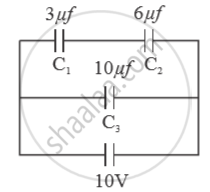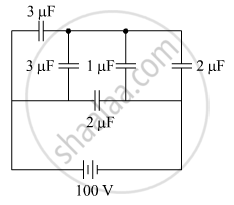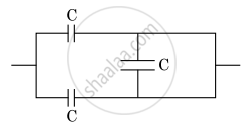Advertisements
Advertisements
Question
Deduce an expression for equivalent capacitance C when three capacitors C1, C2 and C3 connected in parallel.
Solution
An expression for effective capacitance in the parallel grouping of capacitors :
Consider three capacitors of capacitance C1 , C2 and C3 are connected in parallel.
Let Q1, Q2 and Q3 be the charges deposited on the capacitors as shown in the figure.

Suppose a potential difference ‘V ’ is applied across the combination. Then, the potential difference between the plates of each capacitor is V but charges on each capacitor are different. Since different current flows through different branches, so the charges are given by
`Q_1 = C_1V.Q_2 = C_2V. Q_3 = C_3V` ....(i)
From the principle of conservation of charge
`Q = Q_1 + Q_2 + Q_3`
`Q = C_1V + C_2V + C_3V` [From equation (i)]
`∴ Q = V(C_1 + C_2 + C_3)`
If these capacitors are replaced by a single capacitor of capacity CP such that `Q = C_PV` then using equation (ii) we have,
`C_PV = V(C_1+C_2+C_3)`
`C_P = C_1+C_2+C_3`
APPEARS IN
RELATED QUESTIONS
Three capacitors each of capacitance 9 pF are connected in series.
- What is the total capacitance of the combination?
- What is the potential difference across each capacitor if the combination is connected to a 120 V supply?
Figure 4 below shows a capacitor C, an inductor L and a resistor R, connected in series
to an a.c. supply of 220 V

Calculate:
1) The resonant frequency of the given CLR circuit.
2) Current flowing through·the circuit.
3) Average power consumed by the circuit.
The plates of a parallel-plate capacitor are given equal positive charges. What will be the potential difference between the plates? What will be the charges on the facing surfaces and on the outer surfaces?
If the capacitors in the previous question are joined in parallel, the capacitance and the breakdown voltage of the combination will be
The plates of a capacitor are 2⋅00 cm apart. An electron-proton pair is released somewhere in the gap between the plates and it is found that the proton reaches the negative plate at the same time as the electron reaches the positive plate. At what distance from the negative plate was the pair released?
A capacitor of capacitance 5⋅00 µF is charged to 24⋅0 V and another capacitor of capacitance 6⋅0 µF is charged to 12⋅0 V. (a) Find the energy stored in each capacitor. (b) The positive plate of the first capacitor is now connected to the negative plate of the second and vice versa. Find the new charges on the capacitors. (c) Find the loss of electrostatic energy during the process. (d) Where does this energy go?
Three capacitors of capacitance `C_1 = 3muf` , `C_2 = 6muf` , `C_3 = 10muf` , are connected to a 10V battery as shown in figure 3 below :

Calculate :
(a) Equivalent capacitance.
(b) Electrostatic potential energy stored in the system

The figure shows a network of five capacitors connected to a 100 V supply. Calculate the total energy stored in the network.
The equivalent capacitance of the combination shown in the figure is ______.

The capacitors, each of 4 µF are to be connected in such a way that the effective capacitance of the combination is 6 µF. This can be achieved by connecting ______.
